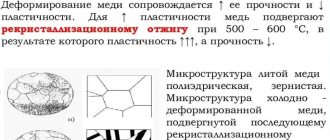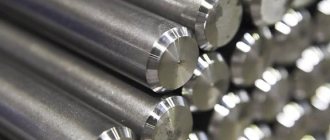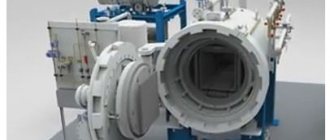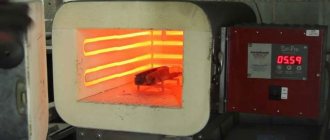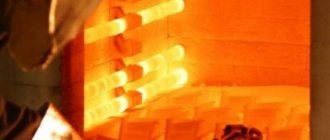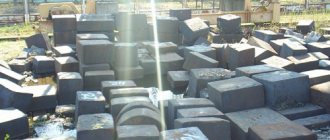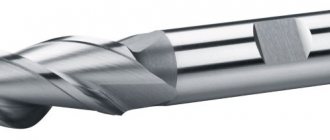Features of heat treatment of alloy steel
TO
category:
Metal technology
Features of heat treatment of alloy steel
Next: Chemical-thermal treatment of steel
For alloy steel, the same types of heat treatment are used as for carbon steel. The difference between the heat treatment of alloy steel and carbon steel is the choice of temperatures and heating rate, the duration of exposure at these temperatures and the cooling method.
Heating of alloy steels during heat treatment should be slower than for carbon steels due to the reduced thermal conductivity of alloy steels and the possibility of cracking during rapid heating. Particular care must be taken when heating steel parts containing elements such as tungsten, which have low thermal conductivity.
The choice of heat treatment temperatures, as is already known, is made depending on the critical points of the steel. All alloying elements can be divided into two groups: elements that increase the critical points ACl and AC3, and therefore heating temperatures during heat treatment, annealing, normalization and hardening, and alloying elements that lower the critical points.
The first group includes chromium (Cr), vanadium (V), tungsten (W), silicon (Si), etc. In this regard, annealing, normalization and hardening of steels containing the listed elements are carried out at higher temperatures than carbon steels .
The second group of elements includes manganese (Mn), nickel (Ni), etc.
In addition to the critical points, when choosing the heat treatment temperature, attention is paid to the tendency of the austenite grain to grow. If the steel is prone to austenitic grain growth, then in order to avoid obtaining a coarse-grained structure, the heat treatment temperature is selected as close as possible to the critical point of the steel. However, this makes it difficult to more completely dissolve alloyed carbides in austenite and obtain alloyed martensite after quenching, which has better properties.
All alloying elements, with the exception of Mn, prevent the growth of austenite grains when heated. Elements that form carbides in steels (chemical compounds with carbon - Cr, W, V) have a particularly strong effect on reducing the growth of austenite grains. Carbides are located along the grain boundaries and impede its growth when heated. Thus, alloy steels (with the exception of manganese steels) are not prone to overheating during heat treatment and can be heated to higher temperatures than for carbon steels.
The holding time during heat treatment of alloy steels is set slightly longer than for carbon steels, since alloy steel has worse thermal conductivity than carbon steel, and it takes more time to completely heat up the part. In addition, to obtain better mechanical properties, exposure is necessary for more complete dissolution of alloyed carbides in austenite.
The cooling rate during heat treatment is set, as is already known, in accordance with the value of the critical quenching rate.
All alloying elements, except cobalt (Co), reduce the critical hardening rate.
In practice, this leads to the fact that most alloy steels are hardened to martensite in oil, i.e., at a lower cooling rate than carbon steel. Some high-alloy steels can even be hardened in air.
Alloy steel has greater hardenability than carbon steel. Among alloy steels, there are those that are calcined through even large sections.
All alloying elements, except A1 and Co, increase the amount of residual austenite in steel after quenching. When containing a large amount of elements such as Ni, Mn, austenite in steel at room temperature can be preserved as long as desired.
The presence of alloying elements in steel makes some changes in the practice of tempering.
Carbide-forming elements (tungsten, vanadium, chromium) contribute to the formation of martensite that is resistant to decay, i.e., red-resistant martensite. Due to this, the high hardness of steel is maintained up to temperatures of 450-550°, while in carbon steel martensite begins to decompose at temperatures of 200-250°, which causes a decrease in the hardness of the steel. High red resistance is a very valuable property for tool steel. The tool heats up during the cutting process, and if the steel is not red-resistant, then it loses its hardness and cutting properties. Therefore, tungsten, vanadium, and chromium are widely used in tool steels. The decomposition of martensite in such steels at 450-550° is accompanied by the release of alloyed carbides, causing a slowdown in the decrease in hardness, and sometimes even an increase in it. Only at temperatures of 650-700°, when alloyed carbides greatly increase in size, does a decrease in hardness and strength occur. Increase
hardness within the temperature range of 450-550° due to the release of carbides is called secondary hardness.
Alloyed retained austenite is highly stable, and its transformation into martensite occurs at significantly higher tempering temperatures than in carbon steel. Thus, in high-speed steel alloyed with chromium, tungsten, and vanadium, the transformation of retained austenite occurs only at a tempering temperature of 550–575°. This transformation consists of partial precipitation of alloying elements in the form of carbides during tempering and the transformation of depleted retained austenite into martensite upon cooling in air. This transformation causes an increase in hardness and is called secondary hardening of steel.
In addition to the listed phenomena that occur during tempering of alloy steels, a different character of change in impact strength depending on the tempering temperature is observed, compared to carbon steel. In carbon steels, the impact strength continuously increases with increasing tempering temperature, up to a temperature of 600-650°. In some alloy steels, after tempering in the temperature range 270–400° and 500–600°, a sharp decrease in impact toughness is observed. Until now, there is no way to eliminate brittleness in the range of 270-400° and therefore this type of brittleness is called irremovable temper brittleness, or temper brittleness of the first kind.
Brittleness in the range of 500-550° is called tempering brittleness of the second type; it can be eliminated by rapid cooling after tempering.
Rice. 1. Change in impact strength of chromium-nickel steel depending on tempering temperature
Steels prone to temper brittleness are not tempered in the temperature range of 270–400° and are cooled rapidly after tempering in the range of 500–550°.
Heat treatment of high-speed steel tools. Tools made of high-speed steel are subjected to heat treatment in order to obtain a red-resistant and wear-resistant structure.
Heat treatment of high-speed steel consists of quenching and repeated tempering; sometimes with intermediate cold treatment.
Rice. 2. Scheme of heat treatment of high-speed steel
High-speed steel contains a large amount of carbides (up to 30-35%). To more completely dissolve these carbides in austenite and obtain red-resistant martensite, high-speed steel is quenched at temperatures close to the melting point. Due to the fact that such high heating of steel will cause significant oxidation and decarburization, heating of steel is usually carried out in salt baths. It is better to heat the steel with preheating at a temperature of 900-950° to avoid cracking.
Heating of high-speed steel tools can be done in chamber or shaft furnaces. Final heating is carried out in electrode bath furnaces.
During final heating for hardening, high-speed steel cutters are heated to a temperature of 1280-1310°.
The holding time at the hardening temperature depends on the cross-section of the tool and is a fraction of a minute. The high quenching temperature and heating in a liquid medium ensure complete heating of the product and possibly more complete dissolution of carbides. However, complete dissolution of carbides does not occur.
Cooling of high-speed steel tools is carried out in oil. Small-section tools made from high-speed steels are hardened directly in air.
After hardening, high-speed steel retains a large amount of retained austenite (up to 40%). This reduces the hardness of the steel. To decompose retained austenite, either cold treatment followed by tempering or multiple tempering is used. Cold treatment is carried out by cooling hardened parts to -80°.
Tempering of high-speed steel is carried out at relatively high temperatures (550-540°), which is explained by the high red resistance of martensite and the high stability of austenite. During holding and tempering, carbides of alloying elements are released from the retained austenite. With subsequent cooling of the steel in air, austenite depleted in alloying elements turns into tempered martensite, which increases the hardness of the steel (secondary hardening). Repeated tempering is given in order to more completely transform retained austenite into martensite.
Examples of heat treatment of some parts
1. Drills—long and thin, the deformation of which during hardening should be insignificant, are made of 9ХС steel. After machining, the drill is quenched and low tempered to improve hardness and wear resistance.
Rice. 3. Drill sketch
Heating for hardening is carried out in an electric furnace-bath. The liquid bath environment ensures minimal surface oxidation, which does not require subsequent deep grinding. Hardening temperature 840-860°. Exposure 3 min. Cooling in oil.
Tempering is carried out in an oil shaft muffle furnace at a temperature of 180-190° for 1 hour.
When hardening and tempering, the drill is immersed vertically to avoid deformation. When immersed in oil during quenching, the shank remains outside and is not hardened. As a result of this, the shank will have a lower hardness than the cutting part of the drill, but higher plastic properties, which will protect it from breakage.
2. The broach, the largest diameter of which is 20 mm and a length of 500 mm, is made of R-18 steel. After preliminary mechanical treatment, the broach is subjected to heat treatment, which consists of hardening followed by tempering three times.
Heating for hardening is carried out with preheating to avoid cracking to temperatures of 800-850°. Chamber ovens can be used for heating. Final heating is carried out in electrode furnaces-baths to temperatures of 1260-1280°. Exposure time 1.5 min. Cooling during hardening is carried out in oil. After hardening, the broach is tempered three times at 550-560° for one hour each. Tempering can be carried out in a shaft furnace with air.
Features of heat treatment of alloy steel
The difference in heat treatment of alloy and carbon steels lies in the choice of different temperatures and heating rates, the duration of exposure at these temperatures and the cooling method.
Alloy steels are less thermally conductive compared to carbon steels. This must be taken into account and especially careful when heating steel parts containing elements such as tungsten.
The critical temperatures of some alloy steels are higher and others are lower; The choice of heat treatment temperatures is made depending on the content of alloying elements in the steel.
All alloying elements can be divided into two groups: elements that increase the critical points AC1 and A C3, and therefore heating temperatures during heat treatment, and elements that lower the critical points. The first group includes Cu, V, W, Si, Mo, Ti, Nb, etc. In this regard, annealing, normalization and hardening of steels containing the listed elements are carried out at higher temperatures than annealing, normalization and hardening of carbon steels. The second group of elements includes Mn, Ni, etc. When choosing the heat treatment temperature, the tendency of the austenite grain to grow is important.
All alloying elements, with the exception of Μn, prevent the growth of austenite grains when heated. A particularly strong influence on reducing the growth of austenite grains is exerted by elements that form carbides in steels (Cr, Mo, W, V, Ti): carbides are located along the grain boundaries and impede its growth when heated. Thus, alloy steels (with the exception of manganese steels) are not prone to overheating during heat treatment; They can be heated to higher temperatures than carbon steels.
holding time is set to be slightly longer than for carbon steels, since alloy steel has poorer thermal conductivity and complete heating of the product requires more time. In addition, to obtain the best mechanical properties, a holding period is required to completely dissolve the alloyed carbides in the austenite.
cooling rate during heat treatment is set in accordance with the stability of supercooled austenite and the value of the critical quenching rate. In practice, this leads to the fact that many alloy steels are hardened to martensite in oil, i.e., at a lower cooling rate than carbon steel.
Alloy steel has greater hardenability; the higher the degree of alloying of steels, the deeper hardenability they have (Fig. 1). Alloying elements in steel affect the stability of martensite during tempering
Rice. 1 . Dependence of hardenability on the content of alloying elements in steel:
1— low hardenability steel (carbon),
2 - steels of medium hardenability (for example, chromium),
3 - steels with increased hardenability (for example, chromium-nickel),
4—highly hardenable steels (chromium-manganese-silicon and other complex alloys); hardened layer is shaded
For example, in tool high-speed steels, carbide-forming elements W, Mo, V, Cr contribute to the formation of red-resistant martensite. Due to this, the high hardness of steel is maintained up to temperatures of 560–600° C, while the martensite of carbon steel begins to decompose at 200–240° C, which reduces the hardness of the steel. High red resistance is a very valuable property of tool steel. The tool heats up during the cutting process, and if the steel is not red-resistant, it loses its hardness and cutting properties.
In addition to the listed features, when tempering alloy steel, one can observe the phenomenon of tempering brittleness , i.e., a decrease in impact strength that occurs despite a decrease in hardness. The reason for temper brittleness is the separation of brittle phases along the grain boundaries of such widespread steels as chromium, chromium-nickel, etc. Temper brittleness can be completely avoided by cooling such steel after tempering not in air, but in oil (large parts - even in water), as well as using well-oxidized steel or other steel grades containing molybdenum or tungsten, which prevent the separation of brittle phases.
Finally, we note another important feature of the heat treatment of alloy steel. When quenching most steels, some of the grains of high-alloy austenite do not undergo a martensitic transformation, and a certain amount of retained austenite remains in the structure of the steel. Since austenite has low hardness (HB 170 - 220), hardened steel has slightly lower hardness and reduced wear resistance. It is not possible to achieve a significant transformation of retained austenite into martensite by tempering. Research carried out by Soviet scientists has shown that the transformation of retained austenite into martensite can be achieved by deep cooling to minus 65 - minus 70 ° C. After holding products at low temperatures for 1-2 hours, a complete transformation of retained austenite into martensite occurs in their structure, and hardness, and with it the wear resistance of products, increases.
Rice. 7.1. Scheme of phase diagrams of iron - alloying element
In austenitic steels, the matrix (main) phase is austenite
(γ), which has an fcc lattice and has paramagnetism (“non-magnetic”).
ferrite
as a matrix phase , which at temperatures below the Curie point (for iron - 768 ° C) has ferromagnetism (“magnetic”).
Influence of alloying elements on the kinetics of austenite decomposition.
To a first approximation, the influence of alloying elements consists, firstly, in increasing the resistance of austenite to decomposition with the formation of pearlite and, secondly, in lowering (except for silicon) the temperature at which the martensitic transformation begins.
This allows us to divide the entire variety of alloy steels into three classes, based on the nature of the structure obtained during cooling in air:
— pearlite class; when cooled in air, perlite is formed (Fig. 7.2.a);
— martensitic class; when cooling in air, martensite is formed, since the critical quenching rate is lower than the cooling rate in air, and the temperature of the onset of the martensitic transformation is above room temperature (Fig. 7.2.b);
- austenitic class; when cooled in air, austenite remains untransformed, since the martensitic transformation begins at low temperatures (Fig. 7.2.c).
Rice. 7.2. Diagrams of austenite decomposition of steels of different classes. An increase in the stability of austenite with the introduction of alloying elements leads to an increase in the hardenability
of steel (the ability of steel to be hardened to a certain depth).
The hardenability of steel is an important characteristic, especially of structural steels used in mechanical engineering. The increased hardenability of steel, assessed by the distance from the surface of the hardened sample to the semi-martensitic zone (50% martensite and 50% troostite) or the critical diameter (the largest diameter of a cylindrical sample, in the core of which no more than 50% troostite is obtained as a result of hardening to martensite), allows even when hardening massive parts, obtain a through martensitic structure, ensuring uniform mechanical properties over the cross section of the product after tempering.
The hardenability of steel can be especially increased by joint alloying with several elements: a combination of chromium and nickel is typical for structural steels; for instrumental ones - chromium, tungsten and molybdenum. So from Fig. 7.3. it can be seen that alloying tool steel with chromium in an amount of 1% (steel 90X) reduces the critical hardening rate by five times, and the additional introduction of 4% tungsten makes it possible to obtain a martensitic structure by cooling the steel in air.
Fig.7.3. Influence of alloying elements (Cr and W) on the character
diagrams of isothermal decomposition of austenite.
a – U8 steel;
b – steel 90Х; c – steel 90ХВ4 Formation of independent phases by alloying elements.
When introduced into steel, alloying elements can be dissolved in ferrite and austenite, increasing their strength, corrosion resistance (chromium, nickel), wear resistance (manganese) and heat resistance (chromium, molybdenum). Certain elements, such as chromium and manganese, can be present in cementite, also increasing its strength.
However, alloying elements have a much greater impact on the properties of steel by forming independent carbide phases, such as Cr7C3, Cr23C6, Mo2C, W2C, VC, NbC, TiC, etc. The formation of dispersed carbide phases leads to an additional increase in the strength of steels being improved, and their wear resistance increases. , which is especially noticeable when using tools made of steel alloyed with tungsten and molybdenum.
In steels with a significant (several percent) content of two or more alloying elements, a high level of mechanical characteristics is achieved due to the formation of intermetallic phases - chemical compounds formed by metals (for example: Ni3
Ti, Ni
3
Al).
- Marking and classification of alloy steels
Marking.
Designations of steel grades consist of a small number of numbers and letters indicating the approximate composition of the steel.
Each alloying element is designated by a letter: N - nickel, X - chromium, G - manganese, C - silicon, M - molybdenum, B - tungsten, T - titanium, F - vanadium, B - niobium.
The first numbers in the grade of structural steel show the average carbon content in hundredths of a percent; in the grade of tool steels - in tenths of a percent (with a carbon content of 1%, the figure may be missed). The number following the letter indicates the approximate content of this alloying element as a percentage (if the content of the element is less than or about 1%, the number is absent).
Example: 30ХГС - 0.28...0.35% C, 0.8...1.1% Cr, 0.9...1.2% Mn, 0.8...1.2% Si.
High-quality alloy steel (P and S less than 0.025% each) has the letter A at the end of the steel grade designation. Classification.
Based on the total
content
of alloying elements, steels are divided into three groups:
- lightly alloyed (up to 3%);
- medium alloyed (from 3 to 10%);
- highly alloyed (more than 10%).
According to the structure
obtained during normalization (cooling in air), alloy steels, as noted above, are divided into three classes:
- pearlitic class (for example, steel 18G2F);
- martensitic class (30Х13);
- austenitic class (12Х18Н10Т).
According to their purpose
, alloy steels are divided into:
- structural: cemented (18KhGT), improved (30KhGSA), spring (60S2A), ball bearing (ShKh15), construction (09G2F), etc.;
- instrumental: for cutting tools (ХВГ), dies (4ХВ2С), rolling rolls (60Х2СМФ), etc.;
- steels with special physical properties: stainless (30Х13, 12Х18Н10Т), heat-resistant (15Х11МФ), wear-resistant (110Г13), etc.
All these classifications are used together when characterizing alloy steels. For example, steel 12Х18Н10Т – high-alloy stainless steel of the austenitic class; steel 50HFA – low-alloy pearlitic spring steel.
- Heat treatment modes for alloy steels
Structural steels.
Critical parts made from
improved
alloy steels are subjected to hardening and tempering. tempering temperature significantly affects the level of mechanical characteristics. This is well illustrated by the example of chromium-nickel steel with different carbon contents, Fig. 7.4. Fig.7.4. Effect of tempering temperature on mechanical properties
(σ in
and ψ) chromium-nickel steel;
a – low carbon steel; b – medium-carbon steel. A typical heat treatment regime to obtain a better set of mechanical properties (a combination of strength and ductility) is: for low-carbon alloy steels – hardening from 900°C in oil with low tempering at 150...200°C (structure – tempered martensite); for medium-carbon alloy steels - hardening from 850°C in oil with high tempering at 550...600°C (structure - sorbitol tempering). The combination of hardening and high tempering is called the “ improvement” operation.
Grades of steels to be improved: 40Х, 40ХНМ, 30ХГС, 38ХН3МФ, etc.
Cementable
alloy steels, after hardening from 780...800°C, are subjected to low tempering at 180...200°C, which ensures that the surface layer of the carburized part remains high after hardening.
Grades of case-hardened steels: 20ХН, 18ХГТ, 12Х2Н4, 18Х2Н4В, etc.
Low tempering at a temperature of 120...160°C is also carried out on ball bearing
steel (ШХ9, ШХ15), ensuring their high wear resistance.
Favorable combination of strength and elastic properties of spring
steels (for example, steel 60C2) is achieved by carrying out quenching from 870°C in medium tempering oil at a temperature of 460°C.
Tool steels . Cutting
tools made of alloy steels, except for high-speed steels (9ХС, ХВГ, ХГСВФ, ХВ5, etc.), intended for processing wood and metal under light cutting conditions, are subjected to heat treatment according to the following scheme: hardening from 800...830°C in oil with low tempering at a temperature of 150...200°C.
Metal cutting tools for severe cutting conditions are made of high-speed steels
, necessarily containing 6...18% tungsten, as well as chromium, vanadium, cobalt, molybdenum (P18, P9, P9K5, R9F5, R6M5, etc.). The final heat treatment of such a tool includes hardening from 1250°C and tempering 2–4 times at 580°C. Sometimes, after hardening, the tool is subjected to cold treatment (- 80°C). after which they take a one-time vacation.
During heat treatment of die
The tool, due to its increased resistance to tempering due to the presence of 2% tungsten (for example, 4ХВ2С, 6ХВ2С), after hardening from 860...900°С (oil), average tempering is used at a temperature of 420...440°С.
The mechanical properties of some grades of structural and tool steels after heat treatment are given in Table 7.1.
Stainless (corrosion-resistant) steel.
The type and mode of heat treatment of stainless steel depends on its class.
Austenitic stainless steels
class (for example, classic chromium-nickel “stainless steel”: 12Х18Н10Т) are subjected to hardening from 1050...1100°C without tempering. Chromium-nickel steel after hardening has increased corrosion resistance and high ductility.
Martensitic stainless steels
class (30X13) are subjected to hardening hardening from 1000...1050°C (air) followed by low or high tempering.
Among stainless steels, low-carbon steels of complex composition with an austenitic-martensitic structure, the so-called maraging steels
steel (for example, 03Х10Н11МД2Т).
These steels, after quenching from 950°C (air), have high ductility, but during subsequent heating (in this case, aging) at a temperature of 400..500°C, they are strengthened due to the release of intermetallic phases (in the presence of aluminum - NiAl, Ni 3
Al, in the presence of titanium – NiTi, Ni
3
Ti), while maintaining high corrosion resistance.
Ferritic
steels (08Х17Т) are subjected only to normalization from 780°C.
The mechanical properties of some stainless steels are given in Table 7.1.
Table 7.1
40ХНМ
Improved Order 830°C (oil)+ holiday 550°С12005860С2Spring Zak.870°С (oil)
+ holiday 460°С150040
Instrument-
steel steel 9ХСCutting
tool Order 840°С (oil)
+ temper 160°СHRC 626ХСStamped Order 860°С (oil)
+ temper 160°СHRC 534ХВ2СStamped Order 880°С (oil)
+ temper 420°СHRC 46 Corrosion-resistant steel
12Х18Н10Т
Austeniticclass Zak.1050°С (water) 8006530Х13 Martensitic
class Zak.1000°С (air-
spirit) + dep.600°C70055
03Х10Н11МД2Т
Martensitosta-
flying steel Order.950°С (air
) + dep.425°С22005408Х17ТFerriticNormalized.780°С50050
In general, the change in properties during heat treatment is determined by the class of steel and the processes occurring during heating and cooling of the steel. Table 7.2 shows the qualitative change in the hardness of steels of different classes after quenching in the same environment and tempering, and also shows the results of a magnetic test.
Table 7.2
Cooling media for hardening
CONTENT
Cooling media for hardening
Cooling during hardening should ensure the formation of a martensite structure within a given cross-section of the product (certain hardenability) and should not cause hardening defects: cracks, deformation, warping and high tensile residual stresses in the surface layers.
A high cooling rate (above: the critical quenching rate) in the temperature range A
1 –
Mn
to suppress the decomposition of supercooled austenite in the region of pearlitic and intermediate transformations and slow cooling in the temperature range of the martensitic transformation
Mn
–
Mk
. A high cooling rate in the martensitic temperature range is undesirable, since it leads to a sharp increase in the level of residual stresses and even to formation of cracks.
At the same time, too slow cooling in the temperature range Mn
-
Mk
can lead to partial tempering of martensite and an increase in the amount of retained austenite due to its stabilization, which reduces the hardness of the steel.
Typically, boiling liquids are used for hardening - water, aqueous solutions of salts and alkalis, oils. When hardening in these environments, three periods are distinguished:
1) film boiling, when a “steam jacket” forms on the surface of the steel; during this period the cooling rate is relatively low;
2) nucleate boiling, which occurs when the vapor film is completely destroyed, observed when the surface is cooled to a temperature below the critical temperature; during this period, rapid heat removal occurs;
3) convective heat exchange, which corresponds to temperatures below the boiling point of the coolant; heat removal during this period occurs at the lowest rate.
Table 2 shows the approximate nucleate boiling temperature range and the relative cooling rate in the middle of this range for various cooling media.
When hardening carbon and some low-alloy steels, which have low stability of supercooled austenite, water and aqueous solutions of NaCl or NaOH are used as a cooling medium.
Water as a cooling medium has significant disadvantages. A high cooling rate in the temperature range of martensitic transformation often leads to the formation of hardening defects; with increasing temperature, the hardening ability sharply deteriorates (Table 1). When quenching products in hot water, due to their slow cooling at high temperatures and rapid cooling at low temperatures, thermal stresses are low, and the most dangerous structural stresses are high, which can cause the formation of cracks. Cold 8–12% aqueous solutions of NaCl and NaOH, which have proven themselves well in practice, have the highest and most uniform cooling ability.
When quenching in aqueous solutions, the steam jacket is destroyed almost instantly, and cooling occurs more uniformly and mainly occurs at the nucleate boiling stage. An increase in cooling capacity is achieved by using jet or shower cooling, which is widely used, for example, in surface hardening.
A further improvement in cooling methods was the use of water-air mixtures supplied through nozzles. Water-air media are used for cooling large forgings, rails, etc.
For alloy steels that have high resistance to supercooled austenite during quenching, mineral oil (usually petroleum) is used.
Oil as a quenching medium has the following advantages: a low cooling rate in the martensitic temperature range, which reduces the occurrence of quenching defects and the constancy of the quenching ability over a wide range of medium temperatures (20–150°).
Disadvantages include increased flammability (flash point 165–300 °C), insufficient stability and low cooling capacity in the region of pearlite transformation temperatures, as well as increased cost.
The oil temperature during quenching is maintained within 60–90 °C, when its viscosity is minimal.
In recent years, instead of water or oil, aqueous solutions of detergents containing surfactants, liquid silicate, and especially synthetic substances, such as aqua-plast, have begun to be used.
Aqua-plast is a concentrate in water of a highly viscous transparent liquid containing water-soluble plastic and a corrosion-protective inhibitor. Solution concentration 0.5–0.7%,
Quenching polymers and detergents in aqueous solutions leads to a decrease in the cooling rate at temperatures below M
n, and as a consequence of this, the formation of cracks is eliminated and warping is reduced.
Article rating:
When hardening, alloy steel is used to cool it. Link to main publication
Related publications
Brand of stainless steel for the food industry How to melt steel at home The difference between damask steel and Damascus steel What kind of steel are files made of Steel pipes for plumbing standard sizes Brand of electrodes for welding stainless steel Classification of steels by weldability Ferromagnetic stainless steel Corrugated stainless steel pipe Steel hardness 95x18 Rockwell Properties steel x12MF Polishing steel to a mirror finish
Hardening technology
The hardening mode is determined by temperature, holding time, cooling rate, and the cooling medium used.
Steel hardening methods:
- in one cooler - used when working with parts of simple configurations made of carbon and alloy steels;
- intermittent in two environments - demanded for processing high-carbon grades, which are first cooled in a rapidly cooling environment (water) and then in a slowly cooling environment (oil);
- jet - usually in demand for partial hardening of a product, carried out in HDTV installations and inductors by spraying the part with a powerful stream of water;
- stepwise - a process in which the part cools in a quenching medium, acquiring the temperature of the quenching bath at all points of the cross-section, final cooling is carried out slowly;
- isothermal - similar to the previous type of steel hardening, differs from it by the time spent in the hardening environment.
Types of Coolants
The final result of the process largely depends on the correct choice of the cooling medium.
- For surface hardening and working with products of simple configurations intended for further processing, water is mainly used. It should not contain salt or detergents, the optimal temperature is +30°C.
Attention! It is not recommended to use this cooling method for parts with complex configurations due to the risk of cracks.
- For products with complex shapes, use a 50% caustic soda solution, which is heated to +60°C. When this composition is used for cooling, the steel acquires a light tint. Caustic soda vapor is harmful to human health.
- For thin-walled parts made of carbon and alloy steels, mineral oils are used to ensure a constant cooling temperature, independent of the ambient temperature. The main condition that must be observed when cooling steels after hardening is the absence of water in mineral oils. Disadvantages of the process: release of vapors harmful to humans, the possibility of oil ignition, plaque formation, gradual loss of effectiveness of the cooling composition.
Attention! To work with products made of carbon steels with complex chemical compositions, combined cooling is used. It consists of two stages. The first is cooling the part in water, the second, after +200°C, in an oil bath. Movement from one cooling medium to another must be done very quickly.
Hardening of alloy and carbon steel
Heating temperatures during quenching and hardness after quenching of various grades of carbon and alloy tool steel are given in Table.
33. Quenching temperatures indicated in table. 33, should be taken at the lower limit (and even slightly lower) if the steel has a thin-plate or point pearlite structure before hardening and at the upper limit (and even 5-10° higher) if a large tool is hardened or if the steel has a non-uniform structure coarse perlite.
Tools of complex shape and large size must be preheated before final heating. temperature 350-450°.
The final heating of the instrument can be carried out in various media: in a furnace, flame or electric, and in liquid baths (in, lead or salt). If, according to the operating conditions of a tool made of alloy steel, it needs to be given high hardness in the surface working layer, for example, in the teeth, and lower hardness and increased viscosity in the underlying layers, then it is better to choose a lead bath as a heating medium: it gives the fastest heating, and therefore, with a short exposure (1-2 minutes), it is possible to obtain the required high hardness in the surface layer up to 10-15 mm deep and a significantly lower one in the core.
A known defect of heating in a lead bath is the adhesion of lead to the surface of the tool, making its subsequent grinding difficult. To reduce such sticking, a small layer of salt and charcoal should be applied to the surface of the lead bath. Liquid salt, which wets the surface of the instrument, prevents the adhesion of lead. In addition, when removing a tool from a lead bath, it should be “shaken.”
Good results are also obtained by heating the tool in molten salt of composition 28, 29 and 30. Their use makes it possible to perform the so-called “light hardening” and completely protect the surface of the tool from oxidation and decarburization, especially when introducing yellow blood salt or carborundum into the salt composition. A bath containing carborundum also forms a protective film on the surface of the tool, protecting it from oxidation when transferred from the bath to a cooling medium (water or oil). This film bounces off when soaked in water or dissolves well when the instrument is subsequently washed. The surface of such a tool after hardening is clean and bright, which makes it possible to reduce the tolerance for subsequent grinding or finishing.
The formation of a film of carborundum or salt on the tool slows down the cooling rate of the steel. Therefore, to obtain the required high hardness and structure, it is necessary to soak the tool in water, and then transfer it to oil, or the heating temperature of the bath for light hardening should be 10-20° higher than those indicated in the table. 33.
However, it must be taken into account that heating in salt containing carborundum or an increased percentage of blood salt (more than 10-15%) causes carburization of the surface layer of the tool. Therefore, if it is necessary to avoid excessive carburization, soaking the instrument in salt should not exceed 1-2 minutes. Some factories successfully use such baths also for hardening files.
When calculating the holding time to obtain continuous heating of the tool, you can adhere to the approximate standards indicated in table. 34. A shorter holding time should be used for carbon steel, and a longer holding time should be used for alloy steel.
The heating rate of a tool in a flame furnace should be calculated experimentally depending on the type of furnace, its power and heating conditions.
Cooling of tools made of steel U8, U9, U10 and U12 and having sharp transitions, in order to avoid the formation of cracks, should be done in water only until the surface darkens, and then transferred to oil. The duration of soaking in water is usually 5-8 seconds. for tools with a cross-section of up to 25 mm and slightly larger for large tools.
Cooling of massive and complex-shaped tools made of steel 9ХС, ХВГ, Х12 and Х12М must be done in molten salt. The temperature of the liquid salt should be 450-500° when cooling tools made from Xl2 and X12M steel and 150-160° when cooling tools made from other steel grades. The compositions of salts with different melting points are given in Chapter. XVI. Cooling in liquid salt significantly reduces tool deformation.
After a high holiday
Tver-reachmagnet-
Naya
samplehard-reach-
magnetic
sample30ХГСАPearlite
class↑+↓+30Х13Martensitic
class↑↑+↓+12Х18Н10ТАaustenitic
classО_О_08Х17ТFerritic
steelО+О+
03Х10Н11МД2Т
Martensito-aging
steel O + ↑↑ +
Note: ↑ – increase; ↑↑ – strong increase; ↓ – decrease; O – no change; + “magnetic”; – “does not magnetize”
It can be seen that the absence of phase transformations in austenitic and ferritic steel does not cause noticeable changes in properties during heat treatment. These steels differ from each other in their reaction to a magnetic field: a sample of ferritic steel is attracted by a magnet (“magnetizes”), while a sample of austenitic steel is not attracted (“does not magnetize”).
During the quenching process (oil), pearlitic steel is characterized by the formation, in addition to hardening structures, of diffusion transformation products, which is manifested in a smaller increase in hardness compared to martensitic steel, which has a higher hardenability.
In maraging steel, ductile martensite is formed during the quenching process, but upon subsequent heating, due to the “aging” processes, a significant increase in hardness is observed.
The information given in Table 7.2 can be used when conducting examination work. on obtaining preliminary information on alloy steels. EXERCISE
- Study and master the theoretical part.
- For five grades of alloy steel (Table 7.2), quench at one temperature (1000°C), measure hardness (HRC) and conduct a magnetic test of the quenched samples.
- After hardening, temper with cooling in air at a temperature of 500°C, measure the hardness and conduct a magnetic test of steel samples after tempering.
- Enter the results obtained in paragraphs 2 and 3 into the table:
Table 1
Why is steel hardening needed and how is it carried out?
Hardening is a type of heat treatment of metals that involves heating above a critical temperature followed by rapid cooling (usually) in liquid media. Critical is the temperature at which a change in the type of crystal lattice occurs, that is, a polymorphic transformation occurs. It is determined by the iron-carbon diagram. photo

